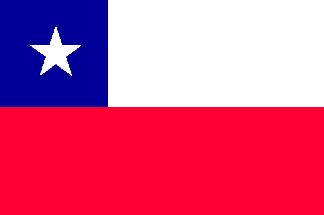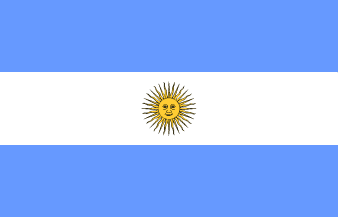Tuesday, 21 February 2006
Bariloche (AR) - Puerto Montt (CL):
12 hours in transit
We rise at 6:45am
and have are own breakfast in our room. Around 8 we are ready at the hotel
reception. But there is no bus to pick us up. Around 8.30 I call the emergency
number, which we were given. 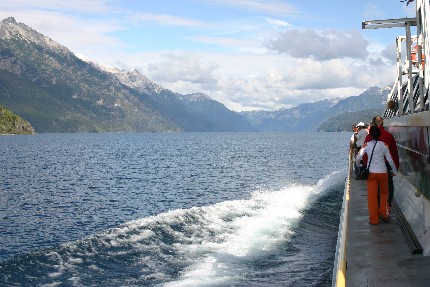 The bus is on its way, I am told, with some delay, but the boat will not leave
until 10, so there is plenty of time.
The bus is on its way, I am told, with some delay, but the boat will not leave
until 10, so there is plenty of time.
At
8.45 bus comes to pick us up and with a few stops along the way it takes us to
the port, Puerto Pañuelo. The we embark for the Cruce de Lagos,
the cruise on the lakes, trough the Andes towards Puerto Montt in Chile. The
first boat trip lasts about one hour and 15 minutes and takes us over Lake Nahuel
Huapi to Puerto Blest. A calm trip along high mountains. At Puerto Blest we have
to get on a particular bus. The logistics are quite complicated, because there
are several different tour programmes running along side each other and the
passengers notice a lot of that. After 3 km over a narrow dirt road we
arrive at Puerto Allegre at the next boat, which will take us to Puerto Frias
over another lake, Lago Frias, in no more than 20 minutes. We see the peak
of the highest mountain around here, the ice capped Cerro Tronador. In Puerto
Frias we have to clear Argentine customs according to a specific order. First an
Israeli travel party followed by us. A bus stands ready to take us through a
dense rainforest through the Andes. After an hour or so we arrive at Peulla. The
Argentine tour leaders have meanwhile been replaced by a Chilean team. Here we
have to clear Chilean customs. The make random checks for fresh food, which is
not allowed into Chile. After that we have an hour and a half to have lunch at a
hotel. 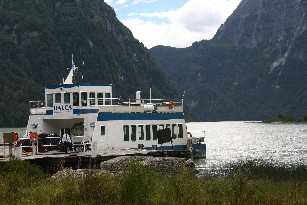 What follows is the final lake crossing to Petrohué over Lago Todos Los
Santos. This takes another hour. The lake has a deep green colour and is very
pretty. In middle of it is the island Margarita. The forests around the lake are
part of a National Park (Vicente
Perez Rosales). The weather is turning bad. It starts to rain. In Petrohué
there is another bus waiting to take us to Puerto Varas. On our ticket it
said
Puerto Montt, but the company has changed that unilaterally. The ride takes us
along the banks of Lago Llanquihue,and after an hour and 20 minutes we
are left to our own devices in rainy Puerto Varas. We take a taxi to Puerto
Montt. Fortunately the 17km ride proves to be not too expensive: CL$9000 or
US$18. We stay in
Hostal Pacifico, a
simple guest house, close to the bus station. At night we walk into town to have
dinner, but that is quite a walk away. We are not spoilt for choice either. We
end up in a hamburger joint, in which several tv sets keep us up to date of
different football matches. That appears to be quite common in Chile and
Argentina. Virtually al bars have a tv permanently switched on, showing
football. Also in the cheaper restaurants all the guests are gazing at the
screens. In some of the guest houses and hotels we were already confronted with
chattering Chilean presenters of various breakfast shows.
What follows is the final lake crossing to Petrohué over Lago Todos Los
Santos. This takes another hour. The lake has a deep green colour and is very
pretty. In middle of it is the island Margarita. The forests around the lake are
part of a National Park (Vicente
Perez Rosales). The weather is turning bad. It starts to rain. In Petrohué
there is another bus waiting to take us to Puerto Varas. On our ticket it
said
Puerto Montt, but the company has changed that unilaterally. The ride takes us
along the banks of Lago Llanquihue,and after an hour and 20 minutes we
are left to our own devices in rainy Puerto Varas. We take a taxi to Puerto
Montt. Fortunately the 17km ride proves to be not too expensive: CL$9000 or
US$18. We stay in
Hostal Pacifico, a
simple guest house, close to the bus station. At night we walk into town to have
dinner, but that is quite a walk away. We are not spoilt for choice either. We
end up in a hamburger joint, in which several tv sets keep us up to date of
different football matches. That appears to be quite common in Chile and
Argentina. Virtually al bars have a tv permanently switched on, showing
football. Also in the cheaper restaurants all the guests are gazing at the
screens. In some of the guest houses and hotels we were already confronted with
chattering Chilean presenters of various breakfast shows.
Weather:
sunny at first and 22 degrees. Later in the afternoon rain and 18 degrees.
Wednesday 22
februari 2006
Puerto Montt - Castro:
172 km
Heavy
thunderstorms passed Puerto Montt during the night, but by the time we are
ready to take a taxi to Hertz the sky starts to clear and the rain has stopped.
At Hertz we get a Peugeot 307. We head for the ferry to Chiloé island.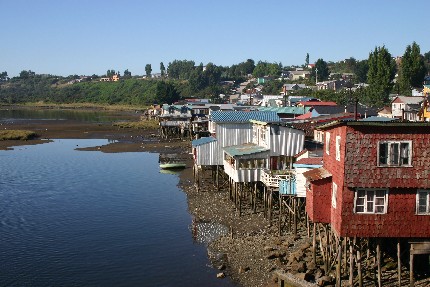 Ferries come and go all the time and the crossing time is around 20 minutes. On Chiloé,
South America's second largest island, we first drive into Ancud, where we have
a coffee. We then continue to Castro, the capital in the centre of the
island, about 106 km south. We get a fairly good impression of Chiloé's
scenery. It is not spectacular. It is mainly hilly and agricultural with some
scattered patches of forest. Castro is busy little town full of wooden
houses, quite a few of them on poles standing along the shore. These are called palifito's. We
stay here at Hosteria
Casita Española, close to the central square. We have lunch at La Brujula del
Cuerpo, next to the old fire station on the central square, the Plaza de
Armas. Most of the dishes have fire related names. On the south side of the
square is the wooden San Francisco church, which was painted orange and purple
on the occasion of pope John Paul II's visit in 1987. The church dates back to 1906
and survived the 1960 earthquake.
Ferries come and go all the time and the crossing time is around 20 minutes. On Chiloé,
South America's second largest island, we first drive into Ancud, where we have
a coffee. We then continue to Castro, the capital in the centre of the
island, about 106 km south. We get a fairly good impression of Chiloé's
scenery. It is not spectacular. It is mainly hilly and agricultural with some
scattered patches of forest. Castro is busy little town full of wooden
houses, quite a few of them on poles standing along the shore. These are called palifito's. We
stay here at Hosteria
Casita Española, close to the central square. We have lunch at La Brujula del
Cuerpo, next to the old fire station on the central square, the Plaza de
Armas. Most of the dishes have fire related names. On the south side of the
square is the wooden San Francisco church, which was painted orange and purple
on the occasion of pope John Paul II's visit in 1987. The church dates back to 1906
and survived the 1960 earthquake.
In the
afternoon we make tour to Delcahue, a traditional fishing village on the east
coast of Chiloé. At the waterfront we see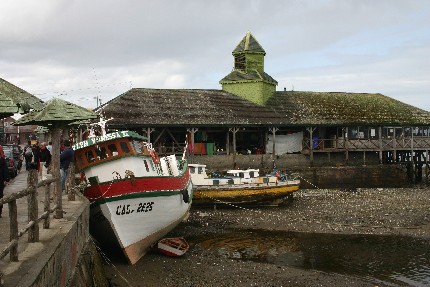 the fishing boats pulled half ashore, waiting for maintenance. Until 1960 most
of the houses here were on poles, but a tsunami washed them all away. On the
central square there is a market hall, where lots of handicraft is on offer. Delcahue
is famous for its knitting ware and we see old ladies knitting away all over town. A
bit further down the street is the the wooden church, one of many on Chiloé. We have a drink in a restaurant on the waterfront with a view on the bay.
Fishing boats come
the fishing boats pulled half ashore, waiting for maintenance. Until 1960 most
of the houses here were on poles, but a tsunami washed them all away. On the
central square there is a market hall, where lots of handicraft is on offer. Delcahue
is famous for its knitting ware and we see old ladies knitting away all over town. A
bit further down the street is the the wooden church, one of many on Chiloé. We have a drink in a restaurant on the waterfront with a view on the bay.
Fishing boats come 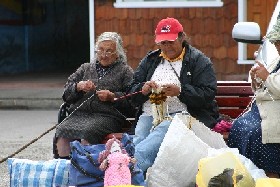 and
go and we watch the fishermen carry their day's catch - lots of shell fish - on
land. and
go and we watch the fishermen carry their day's catch - lots of shell fish - on
land.
At night we
drink cocktails at Años Luz, a trendy watering hole on Plaza de Armas, in
Castro, where you have to see and be seen. The bar is in the shape of a fishing
boat. After that we have dinner at El Sacho, a good fish restaurant.
Weather: sunny 22 degrees, one shower in the afternoon.
Thursday 23 February 2006
After a simple
breakfast we drive to Chonchi, a small village south of Castro with beautiful
wooden houses, a fishing port and a small covered market. Above the market we
have a coffee with a picture perfect view of the quiet bay and the port. Higher
up is the brightly painted, wooden church. After coffee we charge on to Cucoa.
The turn off from Ruta no. 5 to Cucoa is hard to find and the road to Cucoa is
unsealed, dusty and bumpy. The road follows the shores of two beautiful long
stretched lakes - Lago Huillinco and Lago Cacoa - that virtually cut the
island in half. After a good 30 km we reach the ramshackle village of Cucoa at
the entrance of the National Park Chiloé (sector Anay). The road was not opened
until 1983. Before that the village could only be reach via the sea. We have
lunch first and then do a signposted walk, that starts at the CONAF
visitors centre. CONAF is the state organisation that maintains the National
Parks. The Sendero Tepual
takes us through a Tepu for Higher
up is the brightly painted, wooden church. After coffee we charge on to Cucoa.
The turn off from Ruta no. 5 to Cucoa is hard to find and the road to Cucoa is
unsealed, dusty and bumpy. The road follows the shores of two beautiful long
stretched lakes - Lago Huillinco and Lago Cacoa - that virtually cut the
island in half. After a good 30 km we reach the ramshackle village of Cucoa at
the entrance of the National Park Chiloé (sector Anay). The road was not opened
until 1983. Before that the village could only be reach via the sea. We have
lunch first and then do a signposted walk, that starts at the CONAF
visitors centre. CONAF is the state organisation that maintains the National
Parks. The Sendero Tepual
takes us through a Tepu for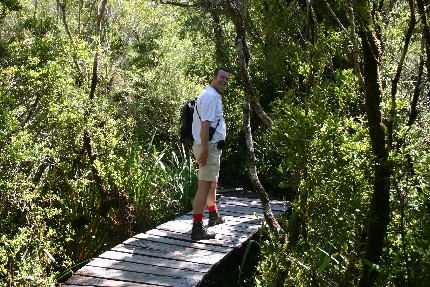 est.
Very thick woods with stilted roots. Tepu grows well in boggy terrain. That is
why the track consists mainly of boardwalks and bridges in the wettest
parts. The loop takes about an hour. After that we follow a track
towards the beach, the Sendero Dunas
de Cucao. The dunes are very deep and after 20 minutes we find ourselves on
the wind swept beach facing the Pacific Ocean. est.
Very thick woods with stilted roots. Tepu grows well in boggy terrain. That is
why the track consists mainly of boardwalks and bridges in the wettest
parts. The loop takes about an hour. After that we follow a track
towards the beach, the Sendero Dunas
de Cucao. The dunes are very deep and after 20 minutes we find ourselves on
the wind swept beach facing the Pacific Ocean.
We drive back to Castro. We
have a problem with opening and locking the car doors. We have it checked at a
service station (after consulting Hertz by phone), but the only thing they can
find is that the left rear door is out of order. We can live with that and go
back to the hotel. At night we have dinner at El Palafitto.
The view is excellent, but the ambiance in this gigantic dining room, where we
initially are the only guests, leaves something to be desired. The food is OK, be
it a bit unimaginative.
Weather:
warm, sunny 23 degrees.
Friday
24 February 2006
Castro - Ancud - Puerto Montt :
180km
After
breakfast we drive to Ancud, the second largest town of the island on the north
coast. We drink coffee (cappuccino Chilean style, with whipped cream) and buy
stamps at the post office. After that we drive to the penguin colony. We
take the Costanera, the coastal road, westbound, 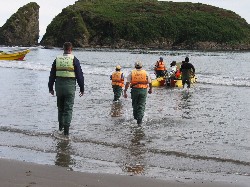 until we reach the turn off to Mar Brava, where we take a left. We follow the
unsealed road for about 20km. The road is bumpy and full of pot holes, yet not
impossible for a regular car. We end up at the beach near the hamlet of
Puñihuil, where fishermen offer boat trips to the penguins. We choose, however,
the Fundación Ottway, who operates respectfully towards the birds,
monitors them and is able to offer insightful commentary. The fishermen are
known for approaching the animals uncomfortably close up, disturbing their
natural habitat. We are given a wading suit and a life vest. The tour is carried
out in a inflatable dingy and we have to walk into the water to reach the boat.
An English speaking guide accompanies us on the tour around a couple of islands
where the penguins live. There are two kinds of penguin here:
Humboldt and Magellan penguins. You can tell them apart by the number of stripes
in their neck. The two live peacefully side by side. For the Humboldt this is
the southernmost spot in Chile. The Magellan can be found all around Patagonia
and Tierra del Fuego. The islets are also home to different kinds of cormorants
and seagulls. We even see a sea otter (one of 5 pairs) and an oyster catcher.
until we reach the turn off to Mar Brava, where we take a left. We follow the
unsealed road for about 20km. The road is bumpy and full of pot holes, yet not
impossible for a regular car. We end up at the beach near the hamlet of
Puñihuil, where fishermen offer boat trips to the penguins. We choose, however,
the Fundación Ottway, who operates respectfully towards the birds,
monitors them and is able to offer insightful commentary. The fishermen are
known for approaching the animals uncomfortably close up, disturbing their
natural habitat. We are given a wading suit and a life vest. The tour is carried
out in a inflatable dingy and we have to walk into the water to reach the boat.
An English speaking guide accompanies us on the tour around a couple of islands
where the penguins live. There are two kinds of penguin here:
Humboldt and Magellan penguins. You can tell them apart by the number of stripes
in their neck. The two live peacefully side by side. For the Humboldt this is
the southernmost spot in Chile. The Magellan can be found all around Patagonia
and Tierra del Fuego. The islets are also home to different kinds of cormorants
and seagulls. We even see a sea otter (one of 5 pairs) and an oyster catcher.
We
drive back to Ancud and have lunch at La Pincoya. I have enormous mussels. We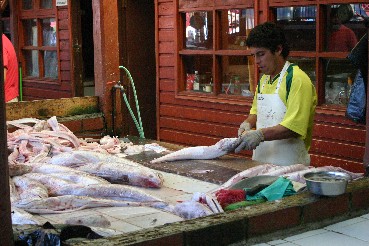 drive on to the ferry taking us back to the mainland. After an another hour we
are back in Puerto Montt, where we stay in Hotel Don Luis, not far from Plaza de
Armas.
Puerto Montt is not a particularly nice town. The centre is busy, but lacks any
sights.
drive on to the ferry taking us back to the mainland. After an another hour we
are back in Puerto Montt, where we stay in Hotel Don Luis, not far from Plaza de
Armas.
Puerto Montt is not a particularly nice town. The centre is busy, but lacks any
sights.
We take a taxi
to Angelmo, the fishing quarter of Puerto Montt with the famous covered fish
market. The market is directly next to the quays and the fish goes directly from
the boats to the market stalls. Not only can you buy your fish here, but you can
also have it prepared and eat in tiny dining rooms behind the stalls. We don't,
it is far to early for dinner to Chilean standards.
Later at
night (between 9 and 10pm) we go out for dinner at a more Chilean time of day in
the posh Club de
Yates, a fishing restaurant built on poles over the sea along the boulevard.
Delicious food, excellent service and none too expensive.
Weather: cloudy
with sunny spells: 24 degrees
|
